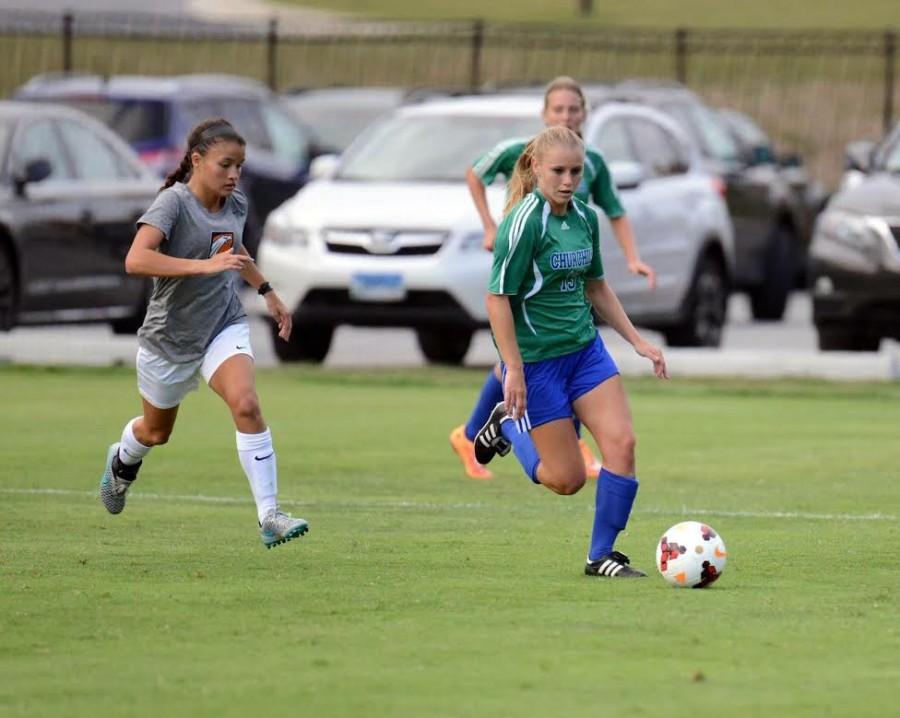Athletic Recruitment Changes College Process
Senior Juliana Comer committed to Cornell for soccer early in her junior year.
October 29, 2015
The pathway to collegiate athletics begins at an early age. Senior Juliana Comer began playing on a recreational soccer team in elementary school with friends. Her passion for soccer during her childhood led her to become a more dedicated athlete and student. Next year, she plans to play soccer for Cornell University.
Being recruited for collegiate athletics is a unique process. For all sports, there are two main types of commitment: verbal and written. Verbal commitments are not binding and student athletes can still go to other schools even after verbally telling a college they will play for them. Written commitments for Division I and II colleges are binding, meaning that student athletes are locked into schools after signing a National Letter of Intent.
“I [verbally] committed to play soccer at Cornell in December of my junior year,” Comer said. “If I wanted to, I could look at or apply to other schools, which I don’t plan on [doing].”
For athletes looking to compete in collegiate sports, the recruitment process begins with stellar athletics and outstanding academics.
“GPA and the SAT and ACT are very important,” CHS Athletic Director Scott Rivinius said. “If an athlete is talented in a certain sport, the higher their academic profile is, [the more it] allows schools to consider them and increases their collegiate options.”
It is a common misconception that just because a student excels at a certain sport, their academics are not up to par. However, most colleges place academics and athletics on an equal playing field when it comes to selecting athletes.
“Colleges expect students to complete their high school career, athletics and academics, at the same level or higher, from the time of their admission,” CHS college counselor Luana Zimmerman said.
Prior to choosing a college, prospective students and college coaches will interact with each other through a variety of showcase events and tournaments.
“My club team has played in many college showcase tournaments over the past few years,” Comer said. “The coaches that I talked to would come to some games to watch my team and me play.”
Once college coaches show interest, students will receive invitations to visit their schools. For some students, the first college they visit is an immediate fit.
“I visited [Penn State] and committed soon after,” said sophomore and Pennsylvania State University lacrosse commit Jimmy Rubino. “I loved everything about Penn State. The coaches, the campus, the academic help and the team ideals were all outstanding and something I very much wanted to be a part of.”
Comer chose Cornell because she thought the team was friendly and welcoming and offered great academics as well as a good soccer team.
For other students, the recruitment process requires visits to other schools or multiple visits to the same school before they decide where to commit.
“I narrowed my options down to three schools, and Wesleyan wasn’t on my list at that point,” said senior and Wesleyan University soccer commit Nicole Brodkowitz. “Then when I visited the school, it blew me away and I ended up liking it way more than any of the other schools.
In the past few years, a common trend among recruiters is that they are selecting athletes at a much younger age.
“Most college coaches are afraid to miss out on a player if they don’t make them an offer early in their high school years,” varsity boys lacrosse coach Jeffrey Fritz said. “As a result, most top recruits have verbally committed to colleges after their freshman year.”
Once students are committed, they must continue to meet certain expectations in order to maintain the agreement.
“In order to keep the offer to play at Cornell, I just have to maintain good grades and submit my application on time,” Comer said. “College offers can be revoked if the athlete’s GPA drops significantly or if they get in trouble at school.”
According to Zimmerman, even though a student can be recruited, they still have to apply to the college that is recruiting them. Once a student commits, they only have to complete the application requirements of the college where they will be competing.
“Being recruited for soccer has definitely relieved some academic pressure in school, and it’s really nice to only have to fill out one college application,” Comer said.
Brodkowitz is also relieved to know where she is going to school and that she doesn’t have the additional work of applications. She still plans to apply early decision to Wesleyan like other students, but she has a slot available to her on the soccer team.
Commitment to a school also diminishes athletic pressure.
“Being committed does not really add to the athletic pressure,” Brodkowitz said. “I’ve always worked as hard as I can so I just have to keep doing that.
Finally choosing a school after the recruitment process is a relief for athletes.
“After committing, I felt a sense of relief because it was [amazing] to finally know where I would be playing, and it was nice to not feel pressure at games with college coaches watching on the sidelines,” Comer said.
Though committing is extremely exciting, getting injured is always a worry for committed athletes because if the commitment is verbal, there is no guarantee the commitment will continue to be valid.
“It’s always scary playing contact sports because there is always a risk of injury, but if you play scared you are more likely to get hurt,” Brodkowitz said.
According to Rubino, to prevent injury over the next two years of his high school career, he will make sure that he stretches and takes care of himself.
Committing to a college is an extremely exciting point in an athlete’s career, and it marks the beginning of a new phase in their life.
“After committing I was immensely proud of myself,” Rubino said.


